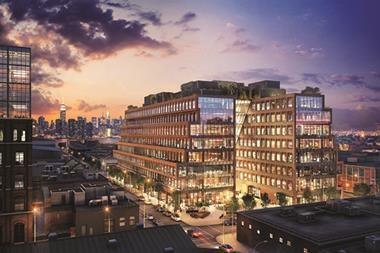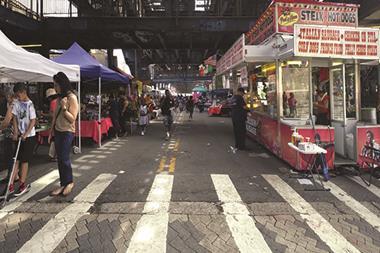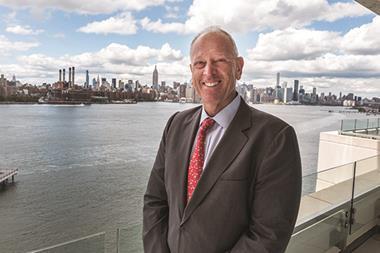It’s been called a ‘city within a city’.

At three times the size of the Rockefeller Center, when it is fully built out, some time around 2040, more than 27m sq ft of new class-A office space, 20m sq ft of new housing, 3m sq ft of hotels and 2m sq ft of retail will have been delivered by developers that include Related Companies, Oxford Properties, Brookfield and Tishman Speyer.
Millions of square feet of space have already been completed and leased to blue-chip occupiers, and further significant deals are rumoured to be on the cards. No wonder the Hudson Yards district is one of the hottest property markets in New York City at the moment.
So how did a development of this scale and ambition come about, who is doing what in the district and where is Hudson Yards’ new office occupier base being drawn from?
Historically the Hudson Yards district consisted of warehousing and industrial space alongside the Manhattan waterfront. The area primarily acted as a rail hub that was fed by the High Line - which closed years ago and has over the past decade been converted into green public spaces - as well as the Long Island Rail Road.
But that all started to change when New York mayor Michael Bloomberg came to power in the early 2000s.
“He noted that the average age of commercial office property in Manhattan was north of 75 years and with that in mind, he said, quite correctly, if we’re going to attract the best and brightest in the TAMI [technology, advertising, media and information] sectors, we’ve got to have some new product,” says Bruce Mosler, chairman of global brokerage at Cushman & Wakefield.
Unique characteristic
Under the guidance of Bloomberg, New York City’s Department of City Planning issued a new masterplan in 2003 for a circa 60-block area that was earmarked for residential and commercial development.
This re-zoning, which essentially allowed developers to replace the existing industrial stock with office, retail and residential buildings, was approved by New York City Council in January 2005 - and so the foundations were laid.
The Hudson Yards commercial district essentially covers 9th Avenue through 11th Avenue going east to west and West 30th Street through West 42nd Street going north to south.
One of the reasons the mayor chose the district as the location for what is essentially a new city is the unique characteristic of the area, according to local historian Kevin Draper.
It’s probably one of the least restricted areas that you could build in - Kevin Draper, local historian
“There are so many places in the city that have landmark buildings and there are also landmark districts that might encompass a five-by-five-block radius where you can’t do anything, but in the Hudson Yards district you have almost no landmark buildings,” he says. “There are also no height limits. It’s probably one of the least restricted areas that you could try and build in. That’s why we’re seeing such explosive growth there.”
Another upside to the district is its unparalleled transport links, which mean there is no need to spend millions of dollars on transportation infrastructure.
“The Seven Line is just one stop from the massive transportation hub at Grand Central,” says Mosler. “We are also one block from Penn Station, which is the most travelled hub in North America and connects to about 13 different lines. That transportation infrastructure has been critical to the area’s success.”
Enormous potential
One of the first developers to spot the potential was New York-based Moinian Group. “We started acquiring parcels of land on this corridor more than 20 years ago,” says Moinian principal Mitch Moinian, one of founder Joe Moinian’s sons.
“Joe Moinian saw the enormous potential that existed - vast swathes of land running along the Hudson River with great views of the entire city - but it’s safe to say that the scope and scale of the overall development that’s happening now, and what’s still to come, have exceeded all our initial expectations.”
Moinian owns 4m sq ft of land on 11th Avenue along the Far West Side, a strip that’s been christened the ‘Moinian Mile’ and encompasses the Atelier, SKY and 572 11th Avenue residential properties in addition to 220 11th Avenue, a residential development designed by the late Zaha Hadid that hasn’t started construction yet.
“Our holdings on 11th Avenue also include 3 Hudson Boulevard, our 1.9m sq ft class-A office tower, which will occupy a full block on 11th Avenue between 34th and 35th Street,” says Moinian. “It is currently under construction and, pending an anchor tenant, we can deliver the full building by 2021.”
The scope and scale of the overall development have exceeded all our initial expectations - Mitch Moinian, Moinian Group
Demand for space in the district is “unprecedented”, he says, adding that the company is currently speaking with several potential anchor tenants.
Although Moinian may have been one of the first groups to spot the opportunity offered by the Hudson Yards district, in terms of delivery of office stock it is lagging behind Related Companies and Oxford Properties’ giant Hudson Yards scheme.
Bob Alexander, chairman of the tri-state region at CBRE, is the letting agent on the scheme, the first phase of which consists of three buildings: 10 Hudson Yards, a 1.8m sq ft office tower that has already completed; 30 Hudson Yards, a 2.6m sq ft tower that will become the world headquarters of Time Warner and regional HQ of Wells Fargo when it is completed in mid-2019; and 55 Hudson Yards, a 1.3m sq ft tower due to be finished by the middle of next year.
Attracting occupiers
Today, all three buildings are fully sold or leased, but Alexander concedes that in the early days it wasn’t easy persuading occupiers to move to the area.
“It was very difficult in 2012-13 when it was just a hole in the ground and Related and CBRE spent an enormous amount of time, effort and energy getting the ball rolling on that because it was just a gleam in someone’s eye at that point,” he recalls. “Obviously, it took off and exceeded everybody’s wildest expectations in terms of leasing and sales.”

Other significant developments at varying stages of delivery in the district include Manhattan West, Brookfield’s massive mixed-use scheme comprising 7m sq ft of office space, nearly 850 luxury apartments, a boutique hotel and retail, and Tishman Speyer’s 1,005 ft-tall Spiral office tower, which will bring another 2.85m sq ft of office space to the area.
Alexander believes that the letting progress that Related and Oxford made at Hudson Yards helped to cement the district’s position as a new office location and will make life easier for developments due to be delivered over the next few years to attract occupiers.
The stock that has so far hit the market or is about to has already attracted a diverse range of occupiers. In addition to TAMI businesses, law firms, large banking groups, fashion brands and pharmaceutical companies have all chosen the district for global and/or regional headquarters.
Some of these occupiers are consolidating space and have moved out of older buildings in Midtown. The trend to move west has been ongoing for the past few years, according to Mosler. “Corporate America has moved across the avenues from Park to Fifth, skipping over Madison to Avenue of the Americas and now we’re seeing this significant commitment to Hudson Yards on the West Side. This is a natural evolution,” he says.
There have been some exceptions to this rule - for instance, Guardian Life and Millbank Tweed moved to the district from Downtown.
Dramatic move
The most notable deal, however, is private equity group Kohlberg Kravis Roberts & Co’s acquisition of more than 300,000 sq ft at 30 Hudson Yards, says Woody Heller, executive managing director and co-head of the capital markets group at Savills Studley in New York.
“To find firms such as Kohlberg Kravis moving from the Solow Building at Nine West 57th Street overlooking Central Park down to Hudson Yards, to me that’s remarkable because that’s a very dramatic change in location,” he says.
Another dramatic change is the rental tone of the district. According to Cushman & Wakefield, grade-A rents are currently around the $97.85/sq ft mark, pushing them significantly above historical values to levels comparable to other key business districts in New York City.
“The economics on the West Side are on par with the top-class grade-A buildings in Midtown and certainly exceed what is going on Downtown,” says Alexander. “The World Trade Center buildings are fantastic buildings and those probably trade at a 15% to 20% discount to Hudson Yards.”
The world is densifying and using less space - Woody Heller, Savills Studley
Mosler expects rents to continue rising. “The West Side is showing significant rent appreciation in the near term as the product that’s going up now becomes more leased and as the vacancy shrinks, product will be at a premium and rents will continue to rise,” he says.
There is, of course, a danger that the district could become a victim of its own success and that rents could grow too quickly, pricing some occupiers out of the market. That potentially creates a problem given the sheer volume of space due to hit the market in the next few years.
“There is concern and it’s a justified concern for the very simple reason that in the 1990s there was 5m sq ft of new office product delivered in Manhattan, in the 2000s there was 6m sq ft and in the 2010s with Hudson Yards and other developments like the World Trade Center we are going to have 28m sq ft added,” says Heller. “That’s a very significant change and it’s particularly significant when you consider that the world is densifying and using less space.”
Modern demands
While these concerns are valid, some local property experts think that New York is well placed to cope. “This city is very much in need of modern office space,” reasons Scott Galin, principal and chief executive at Handler Real Estate Organization.
“If you look at the amount of new office space that’s come on board in the last 10 years, there hasn’t been a tonne of modern office space delivered and the city needs modern office space because people have modern desires, modern uses and modern technology demands.”
Furthermore, points out Mosler, unlike the last development cycle, no one is prepared to take a risk on delivering huge swathes of speculative office space to the market.
Hudson Yards has been an iconic game-changer. It’s acting as a magnetic force and pulling everything west - Scott Galin, Handler Real Estate Organization
“There has been a very strong discipline in place, particularly in New York, in that most of the new product - with some exceptions - has gone up with an anchor tenant in place,” he says. “So the product that has been delivered has been driven by demand and the occupier marketplace.”
It is also worth noting that pretty much all the new office space slated for delivery between 2018 and 2020 has already been spoken for, according to Alexander.
“Now there is a next phase that’s deliverable between 2022 and 2024,” he says. “The space that has been committed to be built at 50 Hudson Yards and 66 Hudson Yards will produce close to 6m sq ft of office space and of that, a little under 2m sq ft has already been committed in the form of Pfizer and BlackRock, so that leaves 4m sq ft to be cared for.”
It is a lot of space, but developers have got another five to seven years to fully let their buildings and in the fast-paced world of the New York real estate sector things can change overnight, as the “metamorphosis” of the Hudson Yards district, as Galin puts it, goes to show.
“Twenty years ago, nobody could have envisioned a city - which is what it is - being built on the train yards,” says Galin. “But Hudson Yards has been an iconic game-changer. It’s acting as a magnetic force and pulling everything west.”
Over the next two decades or so, that magnetic attraction only looks set to grow stronger.






























No comments yet